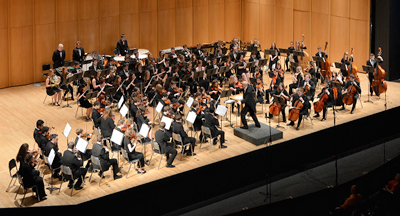by Robert Rollin

George Beelen, Youngstown State University Emeritus Professor and founder of the Ohio Cultural Alliance, helped introduce the concert with a short talk titled “Our Diverse Roots,” summarizing the many cultural groups who built the community. The predominant musical source was Slavic music, amounting to four of the seven works performed. The cleverly chosen program enlivened the Symphony’s birthday celebration.
Bedřich Smetana’s colorfully impressionistic The Moldau, the second of six tone poems from Má vlast, received a gorgeous performance in the hands of conductor Randall Fleischer and the Symphony. The music depicts the course of the famous river (Vltava in Czech) that starts as two small springs, joins into a single current, and becomes the large river that passes by Prague’s renowned Vyšehrad, or High Castle, seat of the earliest Czech kings.
The Symphony’s fine woodwinds began the work with gently swirling flutes, succeeded by more powerful clarinets and, ultimately, the string section and harp. The main “River Theme” enters against the moving current. It is a folk song that has taken several nationalistic forms, including a Swedish version, and the Rumanian one that served as the model for the Israeli national anthem.
The trumpets and horns beautifully depicted a rustic “Farmer’s Wedding” celebration. The “Moonlight Dance of the Mermaids” provided more delicate textures portraying nocturnal serenity, and led to visions of moonlit rocks, castles, and ancient ruins. Excitement built in the “Rapids,” when powerful brasses and percussion seemed to create a storm over the river.
The “River Theme” returns, leading to the more grandiloquent Vyšehrad scene. A quiet serenity ensues, except for the powerful, Beethoven-like final two-chord cadence. Ample percussion, including timpani, cymbals, and bass drum, lent power to the performance. An especially charming off-the-beat accented version of the river theme provided another lively highlight.
Antonín Dvořák’s Slavonic Dance, Op. 46, No. 1 was a delight. The first of the two sets of dances is a perennial audience favorite because of its breakneck pace and lovely orchestration. The woodwinds, particularly the oboes, played beautifully. The performance made the most of the composer’s intricate syncopated rhythms and the mixtures of 3/4 and 6/8 meters.
The Symphony’s performance of Alexander Borodin’s Polovtsian Dances was excellent. Fast and flashy tutti sections alternated with beautiful solos in oboe and English horn on the famous plaintive melody (which would later become “Strangers in Paradise” in the musical Kismet). Other lovely moments included a dashing clarinet solo, graceful flute obbligatos, and exotic moods created by tambourine rolls and other Janissary percussion.
Pyotr Ilyich Tchaikovsky’s Suite No. 4 in G, Mozartiana was an attempt by the composer to familiarize Russian audiences with Mozart’s music. The piece is a transcription of several Mozart keyboard works and all four movements received fine performances. By using harp and extensive percussion the composer made his orchestrations modern by late 19th-century standards. The fourth movement, a setting of Mozart’s Variations on a Theme of Gluck, K. 455, was stunningly attractive. An entire variation is devoted to solos for the concertmaster, and Rachel Stegeman played with power and great expression. The principal clarinet was also given several enchanting solos.
Alexander Glazunov arranged Chopin’s Polonaise militaire in A, Op. 40, No. 1, for orchestra, and pianist/composer Anton Rubinstein called the work the symbol of Polish glory. Glazunov’s orchestration sparkles with fine brass writing, and the performance was outstanding.
Liszt’s Les préludes represented the city’s Hungarians on the program. Highlights of the Youngstown performance included fine cello section lines, a lively bassoon obbligato, excellent French horn section playing of the main theme, an expressive oboe solo accompanied by an attractive solo clarinet obbligato, a terrific brass section climax, and fine percussion playing.
Published on ClevelandClassical.com September 20, 2016.
Click here for a printable copy of this article



